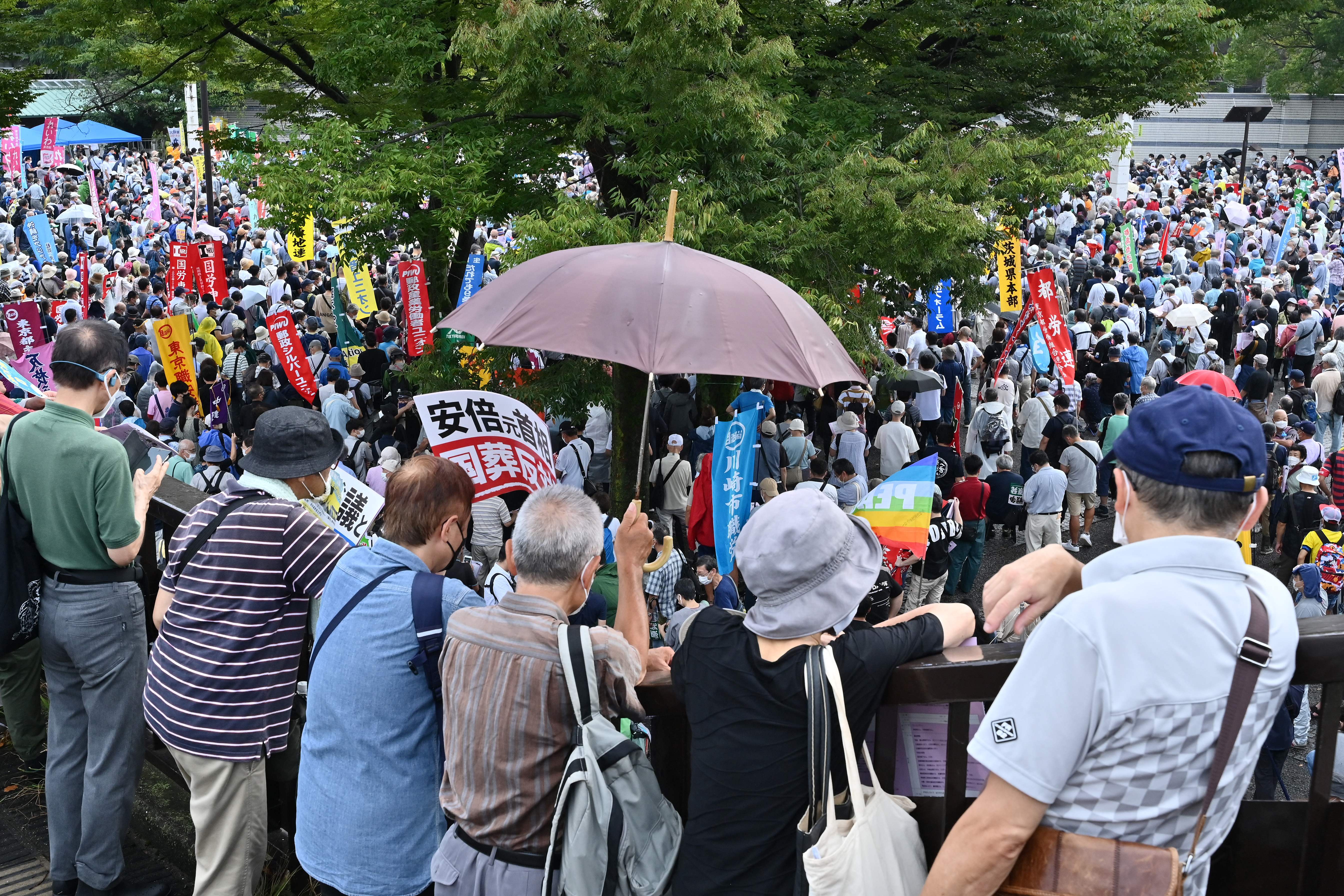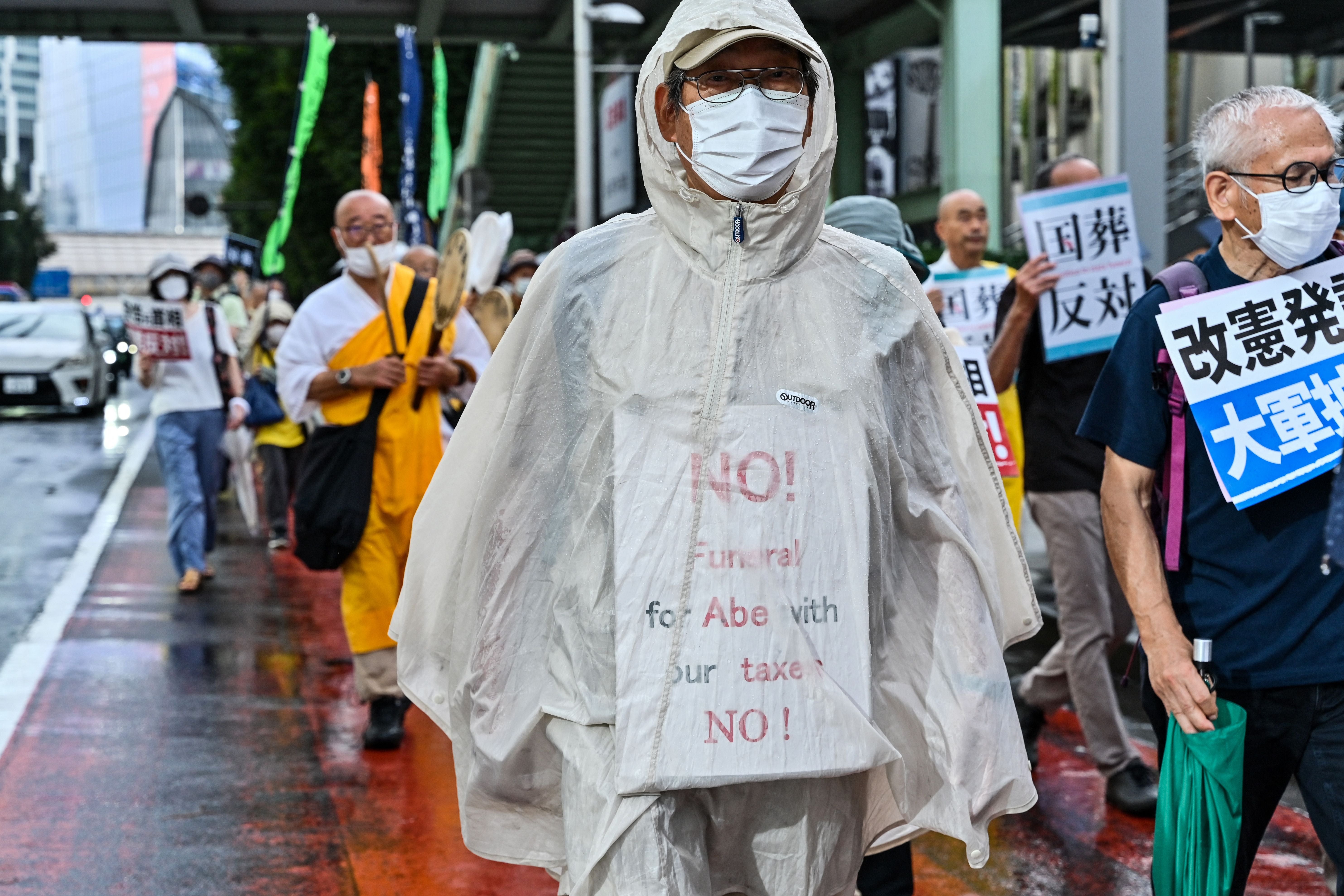Shinzo Abe funeral: World leaders arrive in Japan for lavish state occasion amid public backlash
The funeral is slated to start at 2pm on Tuesday at the Nippon Budokan in central Tokyo
Your support helps us to tell the story
From reproductive rights to climate change to Big Tech, The Independent is on the ground when the story is developing. Whether it's investigating the financials of Elon Musk's pro-Trump PAC or producing our latest documentary, 'The A Word', which shines a light on the American women fighting for reproductive rights, we know how important it is to parse out the facts from the messaging.
At such a critical moment in US history, we need reporters on the ground. Your donation allows us to keep sending journalists to speak to both sides of the story.
The Independent is trusted by Americans across the entire political spectrum. And unlike many other quality news outlets, we choose not to lock Americans out of our reporting and analysis with paywalls. We believe quality journalism should be available to everyone, paid for by those who can afford it.
Your support makes all the difference.The Japanese government is gearing up to hold a lavish taxpayer-funded state funeral for the country's longest-serving prime minister Shinzo Abe on Tuesday despite facing massive protests across the country.
More than 5,000 people, including US vice president Kamala Harris, will be in attendance for the state funeral held at a projected cost of up to $12m (£11m).
Indian prime minister Narendra Modi, who missed the funeral of Queen Elizabeth II last week, will be in the Japanese capital for Abe’s service. Australian prime minister Anthony Albanese, along with three of his predecessors, will also be present in Tokyo to pay their respects.
Since the announcement of the service, the Fumio Kishida government has faced flak from the opposition and public for spending large amounts of taxpayers’ money to host foreign dignitaries for the funeral.
On Monday, nearly 10,000 protesters marched through the streets of Tokyo with demands to call off the occasion. Last week, a man in his 70s set himself on fire near the prime minister's office in the capital to oppose the service.
State funerals are rare in Japan and are usually only reserved for members of the imperial family. The last politician to be accorded the honour was former prime minister Shigeru Yoshida in 1967.
According to recent opinion polls, the majority of people in Japan were unhappy with the expenditure involved in the state funeral, while others opposed it due to Abe’s divisive politics.
However, Tuesday’s event is seen as prime minister Kishida’s political gambit to strengthen his diplomatic ties with allies amid his drastically plummeting public support at home and rising security tensions with neighbours China and North Korea.
Abe, the country’s longest-serving prime minister and former president of the ruling Liberal Democratic Party (LDP), was assassinated on 8 July while giving a campaign speech.

Abe’s suspected shooter, Tetsuya Yamagami, started a conversation around links between the former prime minister and the Unification Church – a religious group that began in South Korea.
The Unification Church has faced allegations of unethically recruiting people and brainwashing them into making huge donations since the 1980s, which Mr Yamagami claimed made his family destitute.
Why are people so opposed to the funeral?
The opposition has largely been fuelled by revelations of alleged links Abe and his LDP had to the Unification Church, which became widely reported after he was gunned down.
The suspected shooter alleged that the church had impoverished his family, according to police.
Since then an investigation by the LDP has concluded that 179 of its 379 lawmakers had interacted with the church on some level.
Who is going to attend Mr Abe’s funeral?
Over 5,000 guests are expected to attend the funeral service.
Among the foreign dignitaries who have been announced as attendees of the state funeral are US vice president Kamala Harris, former British prime minister Theresa May and former French president Nicolas Sarkozy.
Canadian prime minister Justin Trudeau was scheduled to attend the funeral. However, as the extent of the damage wrought by storm Fiona became clear, he cancelled his trip to Japan.

India’s Mr Modi and his Australian counterpart Mr Albanese will be among the leaders in “the Quad” security framework present at the funeral. The Quad involves Japan, the United States, Australia and India, launched at the initiative of Abe to counter China.
From neighbouring countries, South Korean prime minister Han Duck-soo is scheduled to attend the funeral.
Russian president Vladimir Putin will not show up because Japan has imposed sanctions on his country for invading Ukraine.
‘Funeral diplomacy’
The Japanese prime minister is likely to hold talks with about 40 foreign dignitaries over the next few days at the Akasaka state guest house in Tokyo in a flurry of what he has dubbed “funeral diplomacy”.
He has already met with the US vice president, Vietnamese president Nguyen Xuan Phuc, Philippine vice president Sara Duterte and about 10 other foreign dignitaries.
Mr Kishida told Ms Harris that Abe “poured his heart and soul” into strengthening ties between their two countries and it was his “duty” to carry on Abe’s aspirations.
On Tuesday, he is expected to hold talks with the Indian and Australian prime ministers.
What has prime minister Fumio Kishida said about this funeral?
Mr Kishida has apologised and pledged to win back public trust by asking LDP lawmakers to sever ties with the Unification Church. He has acknowledged that the funeral lacks overwhelming public support but has repeatedly sought to justify his decision.
He has praised Abe’s domestic and diplomatic contributions as well as the legacy of his lengthy tenure as reasons why a state funeral is warranted.
During his two stints in office, from 2006 to 2007 and 2012 to 2020, Mr Abe’s nationalist rhetoric and muscular defence policy riled many Japanese wary of any change to the country’s pacifist constitution, drawn up after the Second World War.
What will the ceremony entail?
The memorial service is expected to last for an hour and a half.
After entering the hall, attendees will listen to a speech given by Hirokazu Matsuno, the deputy chair of the funeral committee. They will then rise for the national anthem before observing a moment’s silence.
That will be followed by commemorative speeches, the sending off of Mr Abe’s remains and the laying of commemorative wreaths.
When and where is the funeral being held?
The funeral is slated to start at 2pm on Tuesday at the Nippon Budokan in central Tokyo.




Join our commenting forum
Join thought-provoking conversations, follow other Independent readers and see their replies
Comments